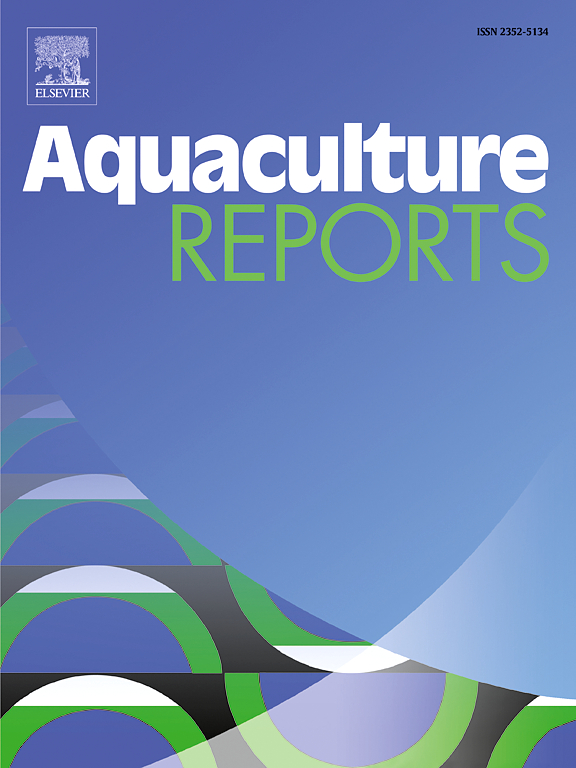单细胞蛋白作为海参幼鱼饲料中的替代蛋白质来源
IF 3.2
2区 农林科学
Q1 FISHERIES
引用次数: 0
摘要
单细胞蛋白(SCP)具有与大多数传统蛋白质来源相当的营养成分,并且可以在较低的环境足迹下生产。寻找替代和美味的蛋白质来源,为幼海参饲料可能解决在这一阶段生长缓慢的问题。为了评估SCP作为单结核stichopus monotuberculatus幼参替代蛋白质来源的效率,本研究在饲料中添加了5个水平的单细胞蛋白质替代(0 %、10 %、15 %、20 %和25 %),以评估其对生长性能、生化组成、消化和免疫酶活性的影响。结果表明,饲料中单细胞蛋白的最佳替代量为15 %,可显著提高单结核葡萄球菌的生长性能。这可能是由于单细胞蛋白的加入增强了免疫酶的活性,其中15% %的处理显示出这些值的最显著增加。氨基酸组成在各处理间相似,但必需氨基酸的比例随着单细胞蛋白的加入而增加。随着单细胞蛋白包涵量的增加,C18:2n-6、C20:2n-6、C20:4n-6、C20:5n-3等多不饱和脂肪酸含量也随之增加,尤其是C20:4n-6和C20:5n-3。与对照组相似,单细胞蛋白替代对胃蛋白酶、胰蛋白酶和脂肪酶的活性没有不良影响。综上所述,单细胞蛋白对单结核葡萄球菌的生长、饲料转化率、生化组成及其免疫能力均有积极影响,具有替代鱼粉作为海参新型有效蛋白的潜力。由此得出,该SCP可作为可持续替代品,替代海参幼鱼饲料中15% %的蛋白质,对其生产性能有积极的促进作用。本文章由计算机程序翻译,如有差异,请以英文原文为准。
Single-cell protein as an alternative protein source in feed for juvenile sea cucumber
Single-cell protein (SCP) has a nutritional profile that is comparable to most conventional protein sources, and can be produced with a lower environmental footprint. Finding alternative and palatable protein sources for juvenile sea cucumber feed may address the issue of slow growth during this stage. To assess the efficiency of SCP as an alternative protein source for juvenile sea cucumbers Stichopus monotuberculatus, a study was conducted with five levels of single-cell protein replacement in the feed (0 %, 10 %, 15 %, 20 %, and 25 %) to evaluate its effects on growth performance, biochemical composition, digestive and immune enzyme activities. The results revealed that the optimal 15 % replacement of single-cell protein in the diet significantly improved the growth performance of S. monotuberculatus. This could be attributed to the enhanced immune enzyme activities resulting from the inclusion of single-cell protein, with the 15 % treatment showing the most significant increase in these values. The amino acid composition was similar across the treatments, but the ratio of essential amino acids increased with inclusion of single-cell protein. As the single-cell protein inclusion increased, the levels of polyunsaturated fatty acids, such as C18:2n-6, C20:2n-6, C20:4n-6 and C20:5n-3 also increased, especially C20:4n-6 and C20:5n-3. Similar to the control, the replacement with single-cell protein did not have adverse effects on the activities of pepsin, trypsin, and lipase. In conclusion, single-cell protein has positive impacts on the growth, feed conversion rate, the biochemical composition of S. monotuberculatus and its immune capacity, which indicates that the single-cell protein has the potential to replace fishmeal as a new effective protein for sea cucumber. We concluded that this SCP can be as a sustainable substitute, capable of replacing 15 % of protein in the diet of juvenile sea cucumber, positively promoting their performance.
求助全文
通过发布文献求助,成功后即可免费获取论文全文。
去求助
来源期刊

Aquaculture Reports
Agricultural and Biological Sciences-Animal Science and Zoology
CiteScore
5.90
自引率
8.10%
发文量
469
审稿时长
77 days
期刊介绍:
Aquaculture Reports will publish original research papers and reviews documenting outstanding science with a regional context and focus, answering the need for high quality information on novel species, systems and regions in emerging areas of aquaculture research and development, such as integrated multi-trophic aquaculture, urban aquaculture, ornamental, unfed aquaculture, offshore aquaculture and others. Papers having industry research as priority and encompassing product development research or current industry practice are encouraged.
 求助内容:
求助内容: 应助结果提醒方式:
应助结果提醒方式:


